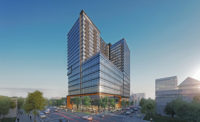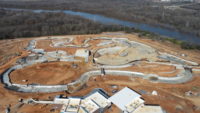City Grill

Robin Terry
Executive Director
AGC West Tennessee
Construction activity is more than steady in Memphis, where contractors are seeing a market bolstered by commercial investments against the headwinds of workforce shortages.
The current status of the market in Memphis area is summed up by Robin Terry, executive director of the West Tennessee Region Associated General Contractors: “My members report they are busier than ever.”
Those members, from general contractors to suppliers, expect no shortage of projects as they look toward the future as well, she says, even if some see a slightly cooling market ahead.
That activity is being driven by big companies spending money to improve facilities, warehouses and campuses. That is expected to continue into next year, says Hunter Pegram, vice president for Hollingsworth Paving and current AGC West Tennessee regional president. He sees that momentum rolling into 2024, but then slowing down.
And Craig Christenbury, chief manager at Chris-Hill Construction Co., who will take over as chairman of the board for AGC of Tennessee in 2024, says Memphis’ continued growth is due to its abundance of distribution services, including five major rail lines, Mississippi River transportation, major interstates and FedEx’s headquarters.
Christenbury says the market’s as busy as it’s been in 20 years, and he doesn’t anticipate any changes in that trajectory.
The quintessential example of that activity, says Terry, is Ford’s BlueOval City near Stanton, Tenn., a massive $5.6-billion facility being constructed to manufacture all-electric pickup trucks.
“The plant is well under construction now and expected to open for production in 2025,” she says. “Construction at this site is not the only impact—it’s expected that there will eventually also be light industrial, commercial, retail and residential construction that will support the plant and its workforce.”
And it’s that residual activity that Terry expects will be felt in surrounding communities and in Memphis, which is about 50 miles and 45 minutes from Stanton. According to Ford, the site will be capable of producing half a million EV trucks annually when production begins on the 3,600-acre campus.
“It’s unionized, and for a company our size, it helps that larger companies have focused on this big project, leaving smaller—our size—projects,” says Pegram.
Memphis International Airport (MEM) is also in the midst of an $800-million terminal modernization project, Christenbury notes.
Work includes expanding the face of the terminal and relocating and reconfiguring vertical circulation and the ticketing lobby. In addition, plans call for constructing a checked bag inspection system, expanding the security screening checkpoint, building an employee screening point and more, according to the airport.
Another big project in the works is Tom Lee Park in downtown Memphis, a full redesign and construction of the site set to last several years. According to Memphis Parks, the 30-acre property adjacent to the Mississippi River will include small hills, paths through forests, a café with porch, covered space for recreation, new entry plaza and a canopy walk.
While Terry says all her members report being busy, they also universally report difficulties in finding skilled workers. That includes Christenbury and Pegram, who says simply, “The labor market is still terrible.”
“Our market is busy, and I see no drop in the increase in potential building in the next two years.”
—Craig Christenbury, Chief Manager, Chris-Hill Construction Co.
That’s one of the thorns in the side of the industry in Memphis, where Pegram says Hollingsworth’s profits are down this year due to not only labor costs but inflation and equipment costs.
“What I’m hearing from my peers is we’re expecting a slower year next year,” he says. “Work and backlog is a lot less going into 2024, but we’ve been anticipating this ever since COVID.”
According to Dodge, construction starts are set to rise modestly between 2023-24 in Memphis, just under $100 million over 2023’s $3.2 billion. The total increase is due in large part to a jump in institutional construction starts overcoming a dip in commercial work. And outside of market ups and downs, labor issues look persistent. “Our market is busy, and I see no drop in the increase in potential building in the next two years,” Christenbury says. “I expect growth in heavy commercial and industrial work, along with heavy civil infrastructure construction. However, I think all of us will still be dealing with a tight labor market.”






Post a comment to this article
Report Abusive Comment